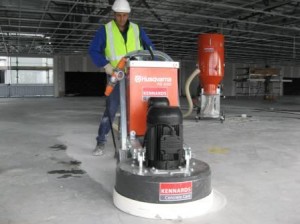Fixing Concrete Slab Prior to Installing Flooring
If you’re going to install flooring directly on concrete, then that concrete has got to be perfect. You have no more flooring layers available to smooth out things before your finish flooring goes down. So, you need to deal with cracks, depressions, and high spots.
And keep in mind that we’re not even talking about the surface itself, which needs to be absolutely clean, oil-free, stain-free, dirt-free, and sealant-free. That’s a whole different matter…
Cracks or Depressions in Concrete Slab
One good thing about repairing cracks in the concrete is that none of this is visible. It’s really difficult to repair concrete cracks and not see the repair areas. Here, all you want to do is get the thing level and smooth.
- Use your ever-ready masonry chisel to chip away at the loose edges of the crack. Anything loose must come out.
- Then, chip away at the bottom of the crack to form a (rough) inverted “V” shape. This will help form a space so that the epoxy goes in…forms a plug…and then won’t come out.
- Clean it all out with a pressure washer or hose. Shop-Vac the crack thoroughly.
- Fill the crack with epoxy patch designed for concrete.
- Trowel smooth.
High Spots in Concrete Slab

High areas in the concrete also need to be brought down. Otherwise, you’ll be bowing out your flooring. Theoretically, this can be done. And that’s one of the benefits of laying ceramic tile: it conforms to the shape of the flooring below. After all, you’ve seen ceramic tile laid on all kinds of curved surfaces such as swimming pools; it can certainly lay down on gently undulating concrete slab.
But do you really want this? Given an option between smooth and flat concrete, you’ll take the “flat” option.
About the only solution is to use a concrete floor grinder. These are serious machines that rent out for $80 to $100 per day. High cost, but you probably will not need the floor grinder for more than a day or two.